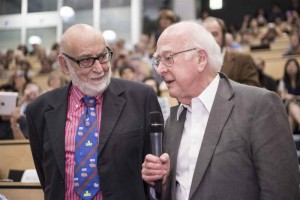
François Englert (left) and Peter Higgs at CERN on 4 July 2012, on the occasion of the announcement of the discovery of a Higgs boson by the ATLAS and CMS experiments (Image: Maximilien Brice/CERN)
I got up at 2am in the morning to watch the announcement of 2013 Nobel Prize in Physics. During an unexpected delay by one hour, thoughts started to wander whether the recipients might also be totally unexpected. But it was worth the wait. The announcement confirmed what we’ve been waiting for: recognition of François Englert and Peter Higgs for their monumental pieces of work.
Why do some forces reach all the way from the Sun to the Earth, while some others work only inside the atomic nuclei? This seemingly very simple question was facing a seemingly insurmountable obstacle. The basic law of forces called gauge theory predicts that forces must be long-ranged. But if this were the case, the Sun would have burnt up too quickly for life to form on the Earth. There were even theorems that did not allow for short-ranged forces. Something had to give. A crazy idea was in order: something is frozen in the empty space of our Universe.
Englert, together with the late Robert Brout, showed that if a symmetry that underlies the gauge theory is broken, the force becomes short-ranged. If this is the case, Peter Higgs showed that there must be an unusual particle yet to be discovered. It must be frozen in our Universe.
On 4 July 2012, a candidate for this particle was announced by the ATLAS and CMS experiments runnning at the LHC. (see NewsLine special issue) A few months later, the new particle showed all signs to qualify for this job. We all thought a Nobel Prize was imminent. And there it is!
The original theoretical papers by Englert-Brout and Higgs, followed by half a century of painstaking effort by experimentalists to prove the theory, demonstrates incredible interplay between the actual phenomena we can observe in experiments and highly abstract mathematical theories. To understand the basic phenomenon of the burning Sun, we needed a short-ranged force, that was elevated to this crazy idea. It in turn predicted an elusive new particle that took thirty years of planning, fifteen years of building, and thousands of people to discover. What an amazing story.
Their theory and the experimental discovery mark a closure of a century-long story: we’ve been trying to understand the basic structure of matter we see around us. Since the discovery of the first elementary particle, the electron, back in 1897, we’ve come a long way. We can now finally explain how atoms, which make up all visible matter around us, can exist. Without the Higgs boson frozen in the Universe, our body would vaporize in a nanosecond.
At the same time, the discovery marks the opening of a new chapter. Only in the last fifteen years, we have learned that our century-long work is far from over. We can only explain 5% of the Universe. Without dark matter, which makes up about 25%, no stars and galaxies would have been born. On the other hand, dark energy, 70% of the Universe, is ripping the Universe apart. The Universe started with the Big Bang, that must have made an equal amount of matter and anti-matter; but why don’t we see anti-matter around us? It may well be thanks to neutrinos, which may turn into anti-neutrinos and back, reshuffling matter and anti-matter. Finally, why is the Universe so big, yet so smooth?
Many of us believe that the new particle holds a key to these mysteries. It is a bizarre particle: it is faceless. All elementary particles we have seen so far spin, like an eternal top. They look different if you look at them from another direction; they have faces. But the Higgs boson doesn’t; it looks the same no matter how you look at it. It is very difficult to believe that there is just one faceless particle in nature that does the most important job. Therefore it is most likely the first one we’ve met in the faceless tribe. It probably has siblings (more Higgs bosons) and relatives (more faceless particles like in supersymmetry). And theoretically, a faceless particle is the best portal to other mysterious particles and forces. We have to study it very very careful to find clues. Remember the precision study of the orbit of Uranus told us that there must be its sibling, Neptune. We need a tool for the precision study of the Higgs boson.
The International Linear Collider (ILC), that smashes elementary particles instead of composite protons as in the LHC, will be a superb tool for this job. Curiously, the whole idea of Englert-Brout-Higgs mechanism was inspired by earlier papers by Yoichiro Nambu, 2008 Nobel Laureate in Physics, who got the idea from superconductivity in the laboratory. And it is this superconductivity that will make the ILC a reality. A circle of life.
Lastly, I truly believe that another Nobel Prize is in order for the ATLAS and CMS experiments. They proved that people around the world could work together to accomplish a common goal, even if they come from countries in political conflict. This is possible because fundamental science like ours is not a pursuit of personal or national interest. It is a true symbol of peace, an activity shared by the whole human race. Attention, Nobel Committee! Ahem, they deserve a Nobel Peace Prize.


Heartiest Congratulations!!!
From Sameen Ahmed KHAN, Salalah College of Technology, Salalah, Sultanate of OMAN.